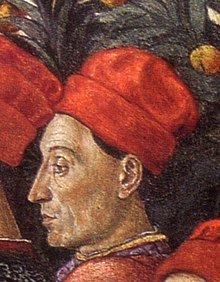Died 1452, Cremona, Italy | ||
 | ||
Books Later travels, Life and Early Travels, Cyriacus of Ancona's journeys in the Propontis and the Northern Aegean, 1444-1445 | ||
Ciriaco de' Pizzicolli or Cyriacus of Ancona (31 July 1391 – 1453/55) was a restlessly itinerant Italian humanist and antiquarian who came from a prominent family of merchants in Ancona. He is called the Father of Archaeology:
« Cyriac of Ancona was the most enterprising and prolific recorder of Greek and Roman antiquities, particularly inscriptions, in the fifteenth century, and the general accuracy of his records entitles him to be called the founding father of modern classical archeology. ».
Unlike many library antiquarians, Ciriaco traveled at first for his family's ventures then to satisfy his own curiosity, all around the Eastern Mediterranean, noting down his archaeological discoveries in his day-book, Commentaria, that eventually filled six volumes. He made numerous voyages in Southern Italy, Dalmatia and Epirus and into the Morea, to Egypt, to Chios, Rhodes and Beirut, to Anatolia and Constantinople, during which he wrote detailed descriptions of monuments and ancient remains, illustrated by his drawings. He was employed by the Ottomans during the 1422 siege of Constantinople. His detailed on-site observations, particularly in lands of the Ottoman Empire, make him one of the precursors of modern archaeology. His accuracy as a meticulous epigrapher was praised by Giovanni Battista de Rossi.
His years in Rome studying Latin are commemorated by his drawings of many of the monuments and antiquities of ancient Rome. In Constantinople he studied Greek. He enjoyed the patronage of Eugenius IV, who had been Papal legate in the March of Ancona from 1420 to 1422, Cosimo de' Medici, and the Visconti of Milan. He was in Siena at the court of Sigismund, and when Sigismund came to Rome for his coronation as Emperor, Ciriaco was his guide among Rome's antiquities. Two years later in 1435, Ciriaco was back exploring in Greece and Egypt.
He was probably the first traveler who recognized the importance of the ruins of Eretria. On 5 April 1436, he described and sketched a plan of the ancient city walls, indicating the position of the theatre and the fortifications of the acropolis and mentioning the existence of inscriptions. He collected a great store of inscriptions, manuscripts, and other antiquities. Through a drawing made for Ciriaco, the appearance of the Column of Justinian is recorded for us, before it was dismantled by the Ottomans. He returned in 1426 after having visited Rhodes, Beirut, Damascus, Cyprus, Mytilene, Thessalonica, and other places.
Pushed by a strong curiosity, he also bought a great number of documents which he used to write six volumes of Commentarii ("Commentaries"). The ravages of time have been unkind to Ciriaco's lifework, which he never published, but which fortunately circulated in manuscript and in copies of his drawings; the Commentarii were lost in the 1514 fire of the library of Alessandro and Costanza Sforza in Pesaro. A series of Pizzicolli's manuscripts about Ancona was destroyed during a fire of the city's archives in 1532.
He retired to Cremona, where he lived so quietly that the year of his death is not certain. Long after his death, some surviving texts were printed: Epigrammata reperta per Illyricum a Kyriaco Anconitano (Rome, 1664) and Itinerarium (Florence, 1742).
« Cyriac of Ancona was the most enterprising and prolific recorder of Greek and Roman antiquities, particularly inscriptions, in the fifteenth century, and the general accuracy of his records intitles him to be called the founding father of modern classical archeology. »
